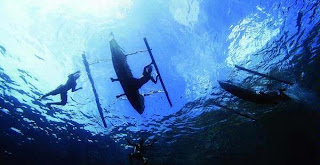Marine life is also threatened by carbon emissions. This is evidenced by studies conducted by two British and Australian researchers who discovered the many organic materials buried in the oxygenated layer of sediment was derived from 85 million years ago.
Using a sample of the material excavated from the ocean floor in the western region of Africa, two researchers studied sediment layers from the Late Cretaceous period (85 million years ago) for a period of 400,000 years. The result, they found that a lot of organic material (marine life) are buried in layers of sediment was oxygenated.
"Our study proves the existence of mass death in the ocean when the earth is undergoing a process with high greenhouse effect of carbon dioxide in the atmosphere and rising temperatures cause the drop in the oxygen needed by the animals in the water," said Kennedy, one of the researchers.
Kennedy said the amount of carbon dioxide in the atmosphere double in the next 50 years will be a crushing blow to the marine ecosystem. Mass extinction of prehistoric marine life could be a warning. Because the greenhouse effect may bring the same thing.
Currently, the dead zone, a region with a very minimal amount of oxygen that it is almost impossible to sustain life, is increasingly widespread in a number of locations and oceans around the world. The total area of low oxygen zones in seas exceeding 240,000 square kilometers. The area is spread over several countries. The largest zone in Mississippi, United States, which reached more than 22,000 square kilometers.
"Many water areas are deprived of oxygen and increased carbon dioxide, temperature, pollution from agricultural wastes, and other trigger factors," he said. Dead zones can occur naturally. However, the rate of human activities make the region more quickly.
This finding itself was published in the journal Proceedings of the National Academy of Science.




0 comments:
Post a Comment